Agriculture video production has emerged as a crucial tool for modern farms striving to boost their visibility and convey complex practices to a global audience. As agriculture evolves, so too must the methods by which farmers communicate. Whether aiming to attract investors, educate consumers, or share innovative techniques, video production stands at the forefront of the agricultural narrative.
From agricultural 360 video production, which offers immersive experiences, to showcasing sustainable practices through traditional videos, the scope for creativity and impact in agriculture video production is vast. This article delves into the essential aspects, strategies, and benefits of producing high-quality agricultural videos.
Clear Purpose and Message
A successful agriculture video production begins with a clear understanding of the purpose and message. Are you aiming to demonstrate new farming technologies, or are you focused on educating about sustainable practices? Defining the message ensures that the video content effectively reaches the intended audience, whether they are seasoned stakeholders or curious consumers. Remember, clarity in communication is key to holding the viewer's interest and enhancing their understanding.
Concise Storytelling
In an age where attention spans are dwindling, concise storytelling is paramount. Videos that capture attention quickly and retain viewer interest through succinct, yet informative, narratives impart the most value. An agriculture video production company specializing in this realm often employs creative storytelling techniques to make complex agricultural processes easily digestible. This effectiveness comes from distilling comprehensive topics into concise, engaging visual stories.
Compelling Visuals and Techniques
Visual appeal plays a pivotal role in effective agriculture video production. Utilizing tools like drones for expansive farm shots or employing agricultural 360 video production to offer immersive views of fields and operations adds a compelling dimension. These techniques are not just eye-catching; they provide viewers with a more profound understanding of agricultural environments. Additionally, compelling visuals highlight the innovation and technological advancements shaping modern farming, thereby attracting a broader audience.
Credible Information and Trust Building
Building trust through credible information is essential. Including expert interviews, data-backed results, and testimonials from seasoned farmers enhances credibility. An agricultural video production company often conducts thorough research to ensure accuracy and trustworthiness. By aligning with credible sources, your videos foster confidence and integrity, making them a reliable resource for both educational and marketing purposes.

AI made with YK
Frequently Asked Questions:
What is the role of agricultural 360 video production?
Agricultural 360 video production allows viewers to experience a farm virtually, providing an immersive view of operations. It is particularly useful for remote learning and marketing, as it creates a virtual tour environment that can be explored from anywhere in the world.
How do I generate agricultural ideas for video production?
Generating ideas can start with understanding your audience's interests. Consider current trends, technological advancements, seasonal activities, and sustainability practices. Collaborating with an agricultural video production company can also bring in fresh perspectives and creative approaches.
What equipment is essential for agriculture video production?
Essential equipment includes high-resolution cameras, drones for aerial shots, microphones for clear audio, and editing software. The choice of equipment may vary based on the complexity of the video project.
FAQ: Agriculture Video Production for Modern Farms
What type of content is usually included in agriculture video production for modern farms?
Agriculture video production for modern farms encompasses a broad spectrum of content, each tailored to highlight different aspects of farming operations, innovations, and community engagement. Here are some common types of content:
- Farm Tours: Virtual tours showcasing the farm operations, crop fields, livestock, and production facilities. This provides a behind-the-scenes look for customers and stakeholders.
- Educational Content: Instructional videos that educate viewers about farming techniques, sustainability practices, and technological advancements in agriculture. These are often used as training material for staff or to engage the community.
- Product Features and Benefits: Videos focusing on the quality, origin, and life cycle of farm products. These highlight the farm-to-table journey and explain the unique selling points of each product.
- Sustainability Practices: Showcasing eco-friendly initiatives and sustainable agriculture practices being implemented on the farm, thereby highlighting the farm's commitment to environmental stewardship.
- Testimonials and Interviews: Interviews with farm owners, workers, and even customers can provide authentic insights into the farm's values and its impact on the community.
- Event Coverage: Documenting farm events, workshops, or local farmer’s markets where the farm participates. This content helps in community engagement and shows active participation in the local economy.
- Day-in-the-Life: Videos that capture a typical day of work on the farm, offering viewers a glimpse into the daily activities and the people who make it all happen.
Why should modern farms consider utilizing agriculture video production?
Modern farms should consider employing agriculture video production for several reasons:
- Enhanced Engagement: Video content is more engaging compared to other forms of media, keeping the audience's attention longer. It is a powerful storytelling medium that can emotionally connect viewers to the farm's mission and values.
- Improved Accessibility: Video production allows farms to reach a wider audience. Through platforms like YouTube and social media, farms can extend their reach beyond local customers to a national or even global audience.
- Increased Visibility: Videos increase a farm's visibility in search engine results. They enhance search engine optimization (SEO), thereby making it easier for potential customers to find the farm online.
- Effective Communication: Videos provide a dynamic platform to disseminate complex information effectively and succinctly, making it easier to communicate farming techniques, sustainability efforts, and product benefits.
- Brand Building: Consistent and high-quality video content contributes to stronger brand identity and recognition, helping modern farms distinguish themselves in a competitive market.
How can agriculture video production enhance my farm's marketing strategy?
Incorporating video production into a farm's marketing strategy can greatly enhance its effectiveness by:
Visual Storytelling: Using compelling narratives and visuals to highlight the farm's ethos, mission, and processes, building a deeper emotional connection with the audience.
Social Media Reach: Video content is highly shareable and can go viral more easily, providing an opportunity to reach new audiences and create a buzz around the farm.
Customer Education: Educating customers about agricultural processes, product benefits, and sustainability practices can foster consumer trust and loyalty.
Data Analytics: Video analytics can provide valuable insights into viewer behavior and preferences, allowing for more targeted marketing campaigns and strategies based on real data.
Building Relationships: Videos showcasing personal stories, customer testimonials, and community engagement can help in building stronger, trust-based relationships with existing and potential customers.

AI made with YK
Who are the target audiences for agriculture video production for modern farms?
Agriculture video production content is typically designed to engage a diverse range of audiences, including:
- Consumers: Individuals interested in learning more about where their food comes from, the quality of the products, and the values of the farms they buy from.
- Retailers and Distributors: Businesses interested in sourcing farm products can benefit from informative videos that detail product quality, farming practices, and logistical capabilities.
- Investors and Partners: Potential investors and business partners look for insightful content that highlights the farm's growth potential, sustainability practices, and market position.
- Agricultural Community: Fellow farmers, agricultural organizations, and farming enthusiasts who are keen on innovations, best practices, and collaborative opportunities.
- Educational Institutions: Schools and universities seeking to integrate practical agricultural knowledge into their curriculum or research.
- Local Community: Residents and local businesses who are interested in supporting local farms and participating in community-driven sustainability efforts.
By addressing each of these target audiences through well-crafted video content, modern farms can effectively communicate their brand story, enhance engagement, and foster valuable relationships.
Conclusion
Effective agriculture video production is a vital asset to modern farms. It plays a significant role in education, innovation, and outreach. By establishing a clear purpose, employing concise storytelling, utilizing compelling visuals, and delivering credible information, agricultural videos can effectively engage and inform a global audience. As agricultural practices continue to advance, embracing video production ensures that these innovations are shared widely and appreciated fully. Investing in this powerful medium not only showcases the robustness and adaptability of modern farming but also bridges the gap between farmers and a digitally connected world.

